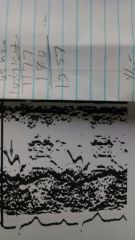![]()
![]()
![]()
Use LEFT and RIGHT arrow keys to navigate between flashcards;
Use UP and DOWN arrow keys to flip the card;
H to show hint;
A reads text to speech;
20 Cards in this Set
- Front
- Back
|
What is the most common cause of PS?
|
congenital
|
|
|
What are three other causes?
|
1. rheumatic (rare)
2. carcinoid 3. prosthetic valve dysfunct |
|
|
What are two different categorizations?
|
1. peripheral - junction of pulm arteries
2. infundibular (subvalvular) |
|
|
What is Noonan Syndrome?
|
a cardiofacial syndrome with PS, HCM and ASD
|
|
|
What happens to RV as result?
|
systolic pressure overload leads to RVH
|
|
|
What might RVH lead to?
|
infundibular stenosis
|
|
|
What are 3 other congenital issues are commonly associated?
|
1. asd
2. vsd 3. ToF |
|
|
Will RV chamber size be normal or enlarged?
|
normal
|
|
|
Will RA be normal or enlarged?
|
enlarged
|
|
|
What is one physical sign?
|
dyspnea on exertion
|
|
|
What murmur is associated?
|
systolic ejection LUSB
|
|
|
Which sound is affected and how?
|
pulmonary ejection sounds
decreased/delayed |
|
|
What are two other signs related to pulse?
|
1. increase a wave or jugular venous pulsation
2. sustained RV impulse at mid-lower LSB |
|
|
What may be seen on mmode wave form?
|
pv a dip over 7mm
|
|
|
What will be seen with the valve? (2 things)
|
thickening and systolic doming
|
|
|
What will be seen with PA?
|
post stenotic dilation
|
|
|
Does PS cause PHTN?
|
no
|
|

|
exaggerated a dip
|
|
|
What are velocities for PS?
|
mild < 3
mod 3-4 sev >4 |
|
|
What are the peak gradients?
|
mild < 36
mod 36-64 sev > 64 |

